Pain Begets Pain and More Pain. Part I
We have made more medical breakthroughs in the last century, especially in the last few decades, that it's hard to believe pain management is no different on the battlefield today than it was during the Civil War. An injection of Morphine is administered to the injured soldier, which provides short-term relief but does not do anything to prevent the pain from continuing long-term.
People in our macho culture wear pain as if it were a badge of courage...as if it's something to be celebrated. This "Look at me...the pain is 'off the charts' excruciating, but it's not going to stop me!"attitude, perhaps, may contribute to the lack of advancement in pain releif.
What is "off the charts" excruciating, anyway? Do any of us have a clue?
My friend's wife was about to have her first baby. Late one night, his wife's water broke. After arriving at the hospital and anxiously waiting a few hours, her pain intensified and hysterically she declared, "This baby must come out...I'm in hard labor"! Do something!
The nurse on duty replied, "If you were in hard labor, you would be in a hell of a lot more pain than you're in right now."
Furious, my friend's wife told the nurse that she had no idea what she was talking about. She then turned to her husband and proceeded to scream and curse at him for using her to house what could only be the creation of Roman Polanski or Richard Donner.
Finally the doctor induced my friend's wife and she went into the hardest labor imaginable. Not only that, the epidural she received caused a severe reaction in her and she was not allowed any more pain medicine. The "Antichrist" did not budge. She spent hours writhing in honest to goodness pain. Needless to say, after experiencing authentic "off the charts" pain, she found she would have welcomed the level of "pain" she experienced earlier with open arms.
Since the degree of pain we feel cannot be measured objectively, only subjectively, it's not a good idea to designate yourself the pain police, unless you have subjected yourself to all types of brutal, horrific pain. The nurse made an educated guess and lucked out, however there are far too many medical professionals who have no idea what real pain feels like, yet act as if they are experts. A person's tolerance for pain and the scale of intensity each person feels differs even when the injury is the same.
Recent studies show early exposure (babies or children) to pain that is not controlled actually enables an overgrowth of the pain neuron system in the spinal cord which increases the level of reactivity (pain) that person feels to the same level of stimulus that someone else who did not endure severe pain as a child would feel.
Pain has evolved as a protective function to warn those suffering that some type of action needs to take place ranging from yanking your hand off a flaming hot burner or getting yourself to the hospital ASAP after crashing into a tree face first in the middle of the night, running at top speed. It may be so dark you can't see a thing including an over-sized, thorny trunked, Honey Locust tree, however the pain felt post-collision clearly lets you know its there and even though you can't see the blood pouring out of every orifice, the pain felt clearly lets you know it's do or die time. Yes, this happened to me...another reason I choose to remain a faceless blogger, however, looking at me now it's barely noticeable except for the embedded thorn. The longer pain goes untreated, the higher the chances that changes in the mechanics of the muscles involved in the area of injury will occur, thus increasing the amount of time pains signals are sent from the periphery.
The longer pain goes untreated, the higher the chances that changes in the mechanics of the muscles involved in the area of injury will occur, thus increasing the amount of time pains signals are sent from the periphery.
Here's the rub...resulting changes in the spinal cord and brain may permanently activate the pain, resulting in chronic pain or Chronic Regional Pain Syndrome, where the smallest movement or the slightest movement of air can activate the pain system.
In addition, because the patient will normally avoid using the affected area, he or she will experience bone absorption, contractures (a shortening or distortion of muscular or connective tissue due to spasm, scar, or paralysis of the antagonist of the contracting muscle) and other problems that create new neural pathways of pain!
How does pain work?
When injured, a signal immediately goes from the wounded tissue into the nerves to your spinal cord and then it is relayed through a set of relay stations in your spinal cord to two parts of your brain, one part of the brains says it’s in my left arm and it’s bad or not so bad, and the other part of the brain says this hurts and I hate it, suffering part.
Then the brain sends a message back down to the spinal cord or the descending control mechanism that says this is really important, this is not so important.
Then you have a reaction around the tissue involved in the injury inflammatory cells are activated and the inflammatory process begins.
Then either healing begins, if the area is stabilized or if it’s a disease process or a disease process that interferes with healing or continues to do something to activate the injury then healing won’t begin.
Next: Part II...More pain.




0 comments:
Post a Comment